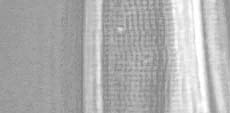This feels like self-flagellation given the state of my camera setup but I just had to see what my 100X objective would do with these diatoms. I had read a number of articles on this exact subject on the Microscopy-UK website and the results others were getting were, to say the least, tantalizing. Since I normally use the 0.63 NA condenser, I removed it and put in a 1.40 NA condenser. A drop of immersion oil on the condenser, lower the slide onto it, another drop on the slide, move the 100X/1.30 oil objective onto the slide and I was away. The filter tray had a green filter and the condenser and aperture diaphragm were adjusted for maximum light and the BF hole of the turret was set slightly off center to provide a bit of oblique illumination. The view, once I got it into focus (no small chore for me at this magnification), was a level beyond what I had experienced before. I saw obvious detail in the 7 diatoms with the largest striae intervals and if I squinted, and held my tongue the right way, I could even see the lines in Amphipleura pellucida. Of course, this detail wasn't present in the images but if you've been following this blog you know why. But I've gotta say, I'm pretty happy with the results after a bit of Elements work in removing the color and sharpening. The magnification of the following images is not constant.
 | |||
| Amphipleura pellucida .27 microns... if you stare REAL hard you can see the lines |
 |
| Frustulia rhomboides .30 microns |
 |
| Pleurosigma angulatum .525 microns |
 |
| Surirella gemma .50 microns |
 |
| Nitzschia sigma .44 microns |
 |
| Stauroneis phoenicentron .72 microns |
 | |
| Navicula lyra 1.25 microns |
 | |
| Gyrosigma balticum .67 microns |

No comments:
Post a Comment